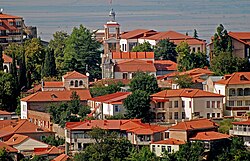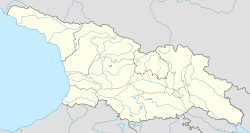




















 Sighnaghi
Sighnaghi
| Sighnaghi სიღნაღი | |
|---|---|
| Sighnaghi | |
|
| |
| Coordinates: | |
| Country | |
| Province | Kakheti |
| City Municipality | |
| Area | |
| - Total | 2,978 km2 (1,149.8 sq mi) |
| Elevation | 836 m (2,743 ft) |
| Lowest elevation | 720 m (2,362 ft) |
| Population (2002) | |
| - Total | 2,146 |
| Time zone | EET |
| - Summer (DST) | EEST (UTC+4) |
| Postal code | |
| Area code(s) | +995 99 |
| Website | www.sighnaghi.ge |
| [1] | |
Sighnaghi (Signagi) (Georgian: სიღნაღი) is a town in Georgia's easternmost region of Kakheti and the administrative center of the Sighnaghi District. It is one of the country's smallest towns with a population of 2,146 as of the 2002 census.[2] Sighnaghi's economy is dominated by production of wine and traditional carpets. The town and its environs are also known for their landscapes and historical monuments. Sighnaghi has recently undergone a fundamental reconstruction program and has become an important centre of Georgia's tourist industry.
Contents[hide] |
[edit] History
The territory of the modern-day town has been settled since the Paleolithic period and was known as Hereti in the Middle Ages, and as Kiziqi after the 15th century. Sighnaghi (literally, "harbor" in Turkish) as a settlement is first recorded in the early 18th century. In 1762, King Heraclius II of Georgia sponsored the construction of the town and erected a fortress to defend the area from marauding attacks by Dagestan tribesmen. As of the 1770 census, Sighnaghi was settled by 100 families, chiefly craftsmen and merchants. When Georgia was annexed by Imperial Russia in 1801, Sighnaghi was officially granted town status and became a centre of Signakh uyezd (Russian: Сигнахский уезд) within Tiflis Governorate in 1802. The town quickly rose in its size and population and became an agricultural centre under the Soviet Union. The severe economic crisis in post-Soviet Georgia heavily affected the town, but a major reconstruction project recently launched by the Government of Georgia and co-funded by several international organizations intends to address an increasing tourist interest and modernize infrastructure.[3]
[edit] Geography and climate
The town has an area of 2.978 km² with 24.3% being residential.[3] Sighnaghi is approximately 113 km southeast of Tbilisi, the capital of Georgia. Sighnaghi District is adjacent, on the town’s east and southwest sides. Sighnaghi is situated in the eastern foothills of the Gombori Range, a watershed between the Iori and Alazani valleys, in a productive agricultural and fruit-growing region. At the elevation of about 790 m above sea level, the town overlooks the Alazani Valley and faces the Greater Caucasus mountains.
Sighnaghi has a mild humid climate. There are four seasons, with winters being moderately cold while summers can be hot. The highest average temperature is in July at 24.3°C while the lowest average temperature is in January at 0.2°C. Average annual precipitation ranges from 602.1 to 949.7 mm,[3] with the heaviest occurring during the spring months and early summer.
[edit] Culture and attractions
Sighnaghi and its environs are home to several historical and cultural monuments and has been specifically protected by the State since 1975. The town is walled with the remnants of 18th-century fortifications. There are two Georgian Orthodox churches in the town itself - one dedicated to St. George and the other to St. Stephen. The venerated Bodbe Monastery is located 2 kilometers from Sighnaghi and is a place of pilgrimage due to its association with St. Nino, the 4th-century apostle of Georgia.
The local Ethnographic and Archaeological Museum dating from the 1950s was upgraded and developed into a modern-standard exhibition - the Sighnaghi Museum - in 2007.[4]






